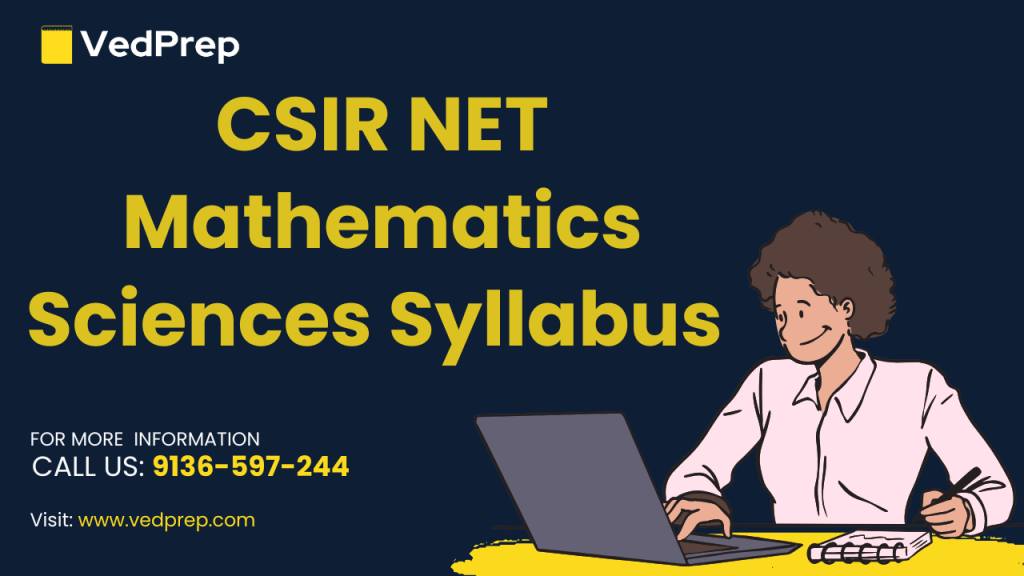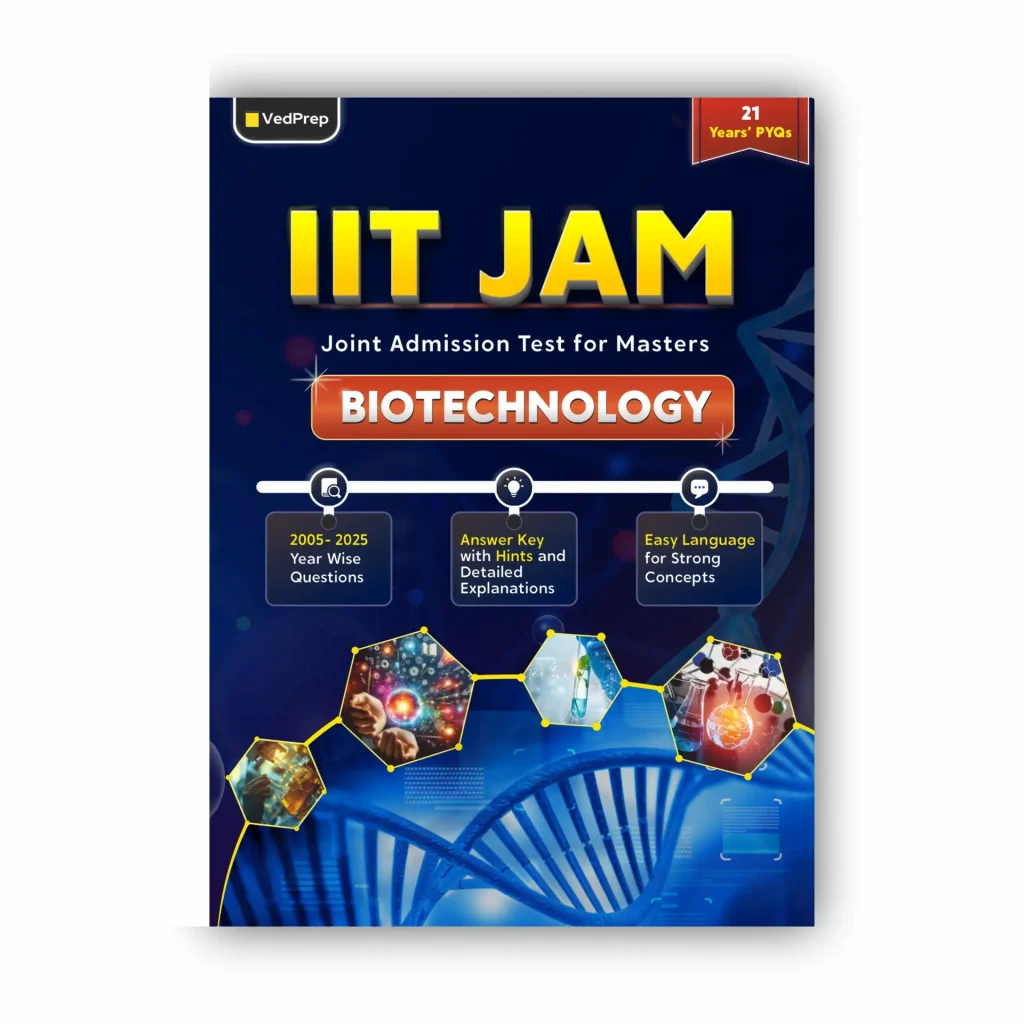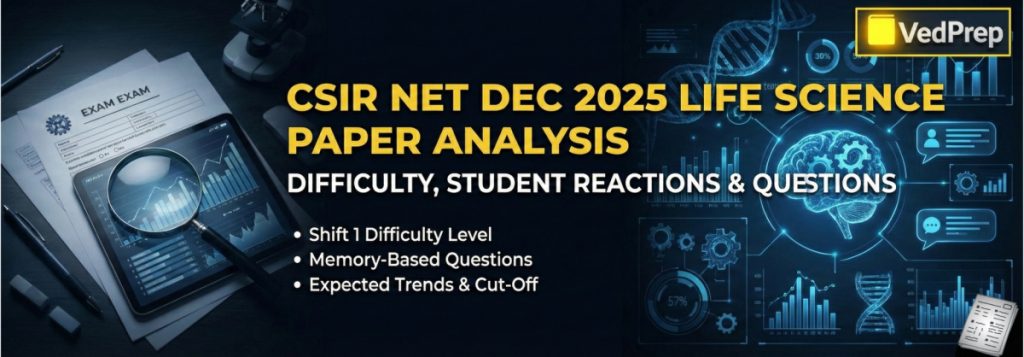CSIR NET Mathematics Sciences syllabus aims to strengthen understanding of mathematical principles and their applications. It emphasizes problem-solving, logical reasoning, and analytical skills across areas such as real analysis, complex analysis, algebra, and statistics. CSIR NET Mathematics preparation is a question many aspirants ask. The key lies in understanding the syllabus thoroughly, covering all important topics like Algebra, Analysis, Mathematical Methods, and Applied Mathematics. Effective preparation involves consistent practice of previous years’ papers and mock tests, maintaining conceptual clarity, and managing time efficiently. By following a structured study plan and focusing on both theory and problem-solving, candidates can systematically prepare for the exam and increase their chances of success.
Also read – Important Topics for CSIR NET Mathematics 2025 : Exam Pattern, Syllabus,age limit, Marking System
CSIR NET Mathematics Sciences Exam Overview
CSIR NET exam is a prestigious national-level examination conducted twice a year by the NTA (National Testing Agency). It covers five subjects: Life Sciences, Physical Sciences, Chemical Sciences, Earth, Atmospheric, Ocean and Planetary Sciences, and Mathematical Sciences. For candidates aspiring to pursue a career as a Junior Research Fellow (JRF) or Assistant Professor in Mathematical Sciences, understanding how to prepare for CSIR NET Mathematics preparation is crucial.
This national-level exam can be effectively cracked with a clear preparation strategy, access to the right study materials, and consistent practice. Candidates must be aware of the best study resources, including vedprep online references, and previous years’ question papers, and know how to use them efficiently.

CSIR NET Mathematics Sciences Exam Preparation Tips
The CSIR NET Mathematical Sciences exam is one of the most competitive national-level exams, conducted by the NTA to select candidates for the roles of Junior Research Fellow (JRF) and Assistant Professor. The exam is divided into three parts – Part A, Part B, and Part C, with a total of 120 questions.
Some of the key topics in the CSIR NET Mathematical Sciences syllabus include:
-
- Linear Algebra
- Complex Analysis
- Ordinary Differential Equations (ODEs)
- Partial Differential Equations (PDEs)
- Classical Mechanics
- And other core areas of mathematical sciences
Also read – Important Topics for CSIR NET Mathematics 2025 : Exam Pattern, Syllabus,age limit, Marking System
Success in this exam depends not only on understanding the concepts but also on strategic preparation. Here, we share some of the best CSIR NET Mathematical Sciences preparation tips that can help candidates plan their study schedule, strengthen problem-solving skills, and increase their chances of cracking the exam.
CSIR NET Mathematics Sciences Exam Pattern
Understanding the exam pattern is a critical step in effective preparation. The CSIR NET Mathematical Sciences exam may seem challenging initially, but with proper analysis,
| Particulars | Details |
| Duration of examination | 3 hours (180 minutes) |
| Total number of questions | 120 |
| Total marks | 200 |
| Type of questions | Objective Type Questions |
| Negative marking | Part A & B: 25%
Part C: No negative marking |
CSIR NET Mathematics Sciences Syllabus preparation
Before starting preparation, the first and foremost step is to thoroughly go through the CSIR NET Mathematics syllabus and exam pattern. Understanding the exam structure, marking scheme, and type of questions helps candidates plan their preparation effectively and know what to expect on the actual exam day.
| Unit | Topics |
| Unit 1 | Analysis, Linear Algebra |
| Unit 2 | Complex Analysis, Algebra, topology |
| Unit 3 | Ordinary Differential Equations (ODEs), Partial Differential Equations (PDEs), Numerical Analysis, Calculus of Variations, Linear Integral Equations, Classical Mechanics |
| Unit 4 | Descriptive Statistics, Exploratory Data Analysis |
- Part B and Part C focus on conceptual understanding and problem-solving in the above topics.
- Candidates must prioritize core areas like Linear Algebra, ODEs, PDEs, and Classical Mechanics as they are frequently asked in previous papers.
- Reviewing the syllabus before planning your study schedule ensures efficient and targeted preparation.
Also read – Important Topics for CSIR NET Physical Science: Syllabus, Best Books, Revision Strategy, PYQs
CSIR NET Mathematical Science Syllabus Unit-wise
The CSIR NET Mathematical Sciences syllabus includes Unit 1, Unit 2, Unit 3 and Unit 4: for complete exam preparation.

CSIR NET Mathematics Sciences Syllabus PDF
Mathematical Sciences Syllabus pdf can be downloaded directly from the link given below or the NTA or CSIR HRDG websites.
| CSIR NET Mathematical Sciences Syllabus PDF | |
| Subjects | Download Link |
| CSIR NET Syllabus Mathematical Sciences | Download PDF |
CSIR NET All Syllabus PDF
The official CSIR NET 2025 syllabus PDF for all subjects (including General Aptitude – Part A, Life Sciences, Chemical Sciences, Physical Sciences, and Earth Sciences) can be downloaded directly from the link given below or the NTA or CSIR HRDG websites.
|
CSIR NET Syllabus PDF |
|
| Subjects | Download Link |
| CSIR NET Syllabus Life Sciences | Download PDF |
| CSIR NET Syllabus Chemical Sciences | Download PDF |
| CSIR NET Syllabus Physical Sciences | Download PDF |
| CSIR NET Syllabus Earth Sciences | Download PDF |
How to Download CSIR NET Syllabus PDF
To download the CSIR NET Syllabus PDF:
- Visit the official National Testing Agency (NTA) CSIR NET website: csirnet.nta.ac.in.
- Look for the “Syllabus” or “Information Bulletin” section on the homepage.
- Download the syllabus PDF for your chosen subject (Life Sciences, Physical Sciences, Chemical Sciences, Earth Sciences, or Mathematical Sciences) from the provided links.
- The downloaded PDF will contain the detailed, topic-wise syllabus for Part A (General Aptitude) and Parts B/C (subject-specific).
Also read – CSIR NET Application Form 2026 : Age Limit, Eligibility Criteria, Process, Fee, Exam Dates, Exam Centres
CSIR NET Mathematics Science Syllabus 2025 Unit-wise Topics
Explore the complete CSIR NET Mathematical Science Syllabus 2025 with detailed unit-wise topics, including Linear Algebra, Algebra, Complex Analysis, Topology, ODEs, PDEs, Integral Equations, Numerical Analysis, Calculus of Variations, Classical Mechanics, and Statistics for effective exam preparation.
Unit 1: Analysis CSIR NET Mathematics Sciences Syllabus
| Main Topic | Subtopics / Concepts | Key Points / Notes |
| Set Theory & Real Numbers | Elementary Set Theory | Basics of sets, operations, relations, Cartesian product |
| Finite, Countable, Uncountable Sets | Classification of sets by cardinality | |
| Real Number System | Complete ordered field; supremum and infimum | |
| Archimedean Property | For any real numbers x,y>0x, y > 0x,y>0, ∃ n∈Nn \in \mathbb{N}n∈N s.t. nx>ynx > ynx>y | |
| Sequences & Series | Convergence of Sequences | Definition of limit; monotone and bounded sequences |
| limsup & liminf | Upper and lower limits of sequences | |
| Series | Convergence tests, absolute and conditional convergence | |
| Theorems in Analysis | Bolzano-Weierstrass Theorem | Every bounded sequence has a convergent subsequence |
| Heine-Borel Theorem | Closed and bounded subsets of Rn\mathbb{R}^nRn are compact | |
| Continuity & Differentiability | Continuity & Uniform Continuity | Definitions and properties |
| Differentiability | Derivative at a point; linear approximation | |
| Mean Value Theorem | Relates derivative to function increments | |
| Sequences & Series of Functions | Pointwise & Uniform Convergence | Definitions; uniform convergence preserves continuity |
| Integration | Riemann Sums & Riemann Integral | Definition of integral using partitions |
| Improper Integrals | Integrals over infinite intervals or with unbounded integrand | |
| Advanced Function Properties | Monotonic Functions | Increasing, decreasing, and their limits |
| Types of Discontinuity | Removable, jump, essential | |
| Bounded Variation | Functions whose total variation is finite | |
| Lebesgue Measure & Integral | Generalization of length and integral for more functions | |
| Functions of Several Variables | Directional & Partial Derivatives | Rate of change in a direction or along coordinate axes |
| Derivative as Linear Transformation | Total derivative as a linear map approximating function | |
| Inverse & Implicit Function Theorems | Conditions for existence of local inverse or implicit functions | |
| Metric Spaces & Topology | Metric Spaces | Definition, open/closed sets, convergence |
| Compactness & Connectedness | Fundamental topological properties | |
| Normed Linear Spaces & Functional Analysis | Normed Spaces | Vector spaces with norm; convergence and completeness |
| Spaces of Continuous Functions | Examples of normed spaces; sup norm, C[a,b] |
Unit 1: Linear Algebra CSIR NET Mathematics Sciences Syllabus
| Main Topic | Subtopics / Concepts | Key Points / Notes |
| Vector Spaces | Vector Spaces & Subspaces | Definition, examples, closure under addition and scalar multiplication |
| Linear Dependence & Independence | Linear combination of vectors; dependence criteria | |
| Basis & Dimension | Minimal generating set; dimension as number of basis vectors | |
| Algebra of Linear Transformations | Addition, scalar multiplication, composition of linear maps | |
| Matrices & Linear Equations | Algebra of Matrices | Matrix addition, multiplication, transpose, inverse |
| Rank & Determinant | Rank: dimension of row/column space; determinant properties | |
| Linear Equations | Systems of equations; solutions via matrix methods | |
| Eigenvalues & Eigenvectors | Eigenvalues & Eigenvectors | Av=λvAv = \lambda vAv=λv; spectral properties |
| Cayley-Hamilton Theorem | Every square matrix satisfies its characteristic equation | |
| Matrix Representation | Linear Transformations as Matrices | Representation depends on choice of basis |
| Change of Basis | Similarity transformations; coordinate changes | |
| Canonical Forms | Diagonal, triangular, Jordan forms; simplification of matrices | |
| Inner Product Spaces | Inner Product & Orthonormal Basis | Length, angle, orthogonality, Gram-Schmidt process |
| Quadratic Forms | Quadratic Forms | Expression Q(x)=xTAxQ(x) = x^T A xQ(x)=xTAx; symmetric matrices |
| Reduction & Classification | Diagonalization; positive definite, negative definite, indefinite forms |
You can also check – How to prepare for CSIR NET Mathematics preparation : Syllabus,Tips Preparation strategy, Books
Unit 2: Complex Analysis CSIR NET Mathematics Sciences Syllabus
| Main Topic | Subtopics / Concepts | Key Points / Notes |
| Complex Numbers & Functions | Algebra of Complex Numbers | Addition, multiplication, modulus, conjugate, polar form |
| Complex Plane | Representation of complex numbers; Argand diagram | |
| Polynomials & Power Series | Roots of polynomials, radius of convergence, analytic properties | |
| Transcendental Functions | Exponential, logarithmic, trigonometric, hyperbolic functions in complex domain | |
| Analytic Functions | Analyticity | Function differentiable in complex sense; Cauchy-Riemann equations |
| Cauchy-Riemann Equations | Necessary condition for differentiability of complex functions | |
| Complex Integration | Contour Integrals | Line integrals along paths in complex plane |
| Cauchy’s Theorem | Integral over closed contour of analytic function is zero | |
| Cauchy’s Integral Formula | Value of analytic function inside contour in terms of integral over contour | |
| Liouville’s Theorem | Bounded entire functions are constant | |
| Maximum Modulus Principle | Maximum of modulus occurs on boundary of domain | |
| Schwarz Lemma | Bounds analytic functions mapping unit disk to itself | |
| Open Mapping Theorem | Non-constant analytic functions map open sets to open sets | |
| Series Expansion & Residues | Taylor Series | Power series expansion around regular point |
| Laurent Series | Expansion with negative powers around singularity | |
| Calculus of Residues | Residue theorem for evaluating integrals; poles, essential singularities | |
| Conformal Mappings | Conformal Maps | Angle-preserving maps; locally analytic and non-constant |
| Möbius Transformations | Linear fractional transformations; preserve circles and angles |
Unit 2: Algebra CSIR NET Mathematical Sciences Syllabus
| Main Topic | Subtopics / Concepts | Key Points / Notes |
| Combinatorics | Permutations | Arrangement of nnn objects in order; with/without repetition |
| Combinations | Selection of rrr objects from nnn without order; (nr)=n!r!(n−r)!\binom{n}{r} = \frac{n!}{r!(n-r)!}(rn)=r!(n−r)!n! | |
| Pigeonhole Principle | If nnn objects in mmm boxes with n>mn>mn>m, at least one box contains >1 object | |
| Inclusion-Exclusion Principle | Counting union of overlapping sets: ( | |
| Derangements | Permutations where no element is in its original position; !n=n!∑k=0n(−1)kk!!n = n!\sum_{k=0}^{n} \frac{(-1)^k}{k!}!n=n!∑k=0nk!(−1)k | |
| Number Theory | Fundamental Theorem of Arithmetic | Every integer >1 can be expressed uniquely as a product of primes |
| Divisibility in Z\mathbb{Z}Z | (a | |
| Congruences | (a \equiv b \ (\text{mod } n) \iff n | |
| Chinese Remainder Theorem | System of congruences with coprime moduli has a unique solution modulo the product | |
| Euler’s ϕ\phiϕ-function | Counts integers ≤ n coprime to n; ϕ(pk)=pk−pk−1\phi(p^k) = p^k – p^{k-1}ϕ(pk)=pk−pk−1 | |
| Primitive Roots | ggg is primitive root modulo n if all numbers coprime to n are powers of ggg | |
| Group Theory | Groups & Subgroups | Definitions, examples, subgroup criteria |
| Normal Subgroups & Quotient Groups | N◃GN \triangleleft GN◃G; cosets form quotient group G/NG/NG/N | |
| Homomorphisms & Cyclic Groups | Structure-preserving maps; groups generated by single element | |
| Permutation Groups | Groups of bijections under composition | |
| Cayley’s Theorem | Every group is isomorphic to a subgroup of a symmetric group | |
| Class Equations | ( | |
| Sylow Theorems | Existence, conjugacy, and number of subgroups of order pkp^kpk in finite groups | |
| Ring Theory | Rings & Ideals | Set with two operations; ideals closed under addition and multiplication by ring elements |
| Prime & Maximal Ideals | Prime: ab∈P ⟹ a∈Pab \in P \implies a \in Pab∈P⟹a∈P or b∈Pb \in Pb∈P; Maximal: no ideal strictly between MMM and RRR | |
| Quotient Rings | R/IR/IR/I with addition and multiplication modulo I | |
| UFD, PID, Euclidean Domain | Unique factorization, principal ideal generation, division algorithm | |
| Polynomial Rings | Polynomial Rings | Rings of polynomials R[x]R[x]R[x] |
| Irreducibility Criteria | Eisenstein criterion, degree tests | |
| Field Theory & Galois Theory | Fields & Finite Fields | Commutative rings with inverses; GF(pn)GF(p^n)GF(pn) |
| Field Extensions | F⊆KF \subseteq KF⊆K, KKK extension of FFF | |
| Galois Theory | Connection between field extensions and group theory; solvability of polynomials |
Unit 2: Topology CSIR NET Mathematics Sciences Syllabus
| Main Topic | Subtopics / Concepts | Key Points / Notes |
| Topology | Basis | Collection of open sets such that every open set can be expressed as a union of them |
| Dense Sets | A subset DDD of XXX is dense if every point of XXX is either in DDD or is a limit point of DDD | |
| Subspace Topology | Topology induced on a subset Y⊆XY \subseteq XY⊆X from the parent space XXX | |
| Product Topology | Topology on a product of spaces; open sets are products of open sets of component spaces | |
| Separation Axioms | T0, T1, T2 (Hausdorff), T3, T4: conditions that separate points and closed sets | |
| Connectedness | A space is connected if it cannot be represented as the union of two non-empty disjoint open sets | |
| Compactness | Every open cover has a finite subcover; in metric spaces, equivalent to sequential compactness |
Unit 3: Ordinary Differential Equations (ODEs) CSIR NET Mathematical Sciences Syllabus
| Main Topic | Subtopics / Concepts | Key Points / Notes |
| First-Order ODEs | Existence & Uniqueness | Conditions for solutions of initial value problems (IVPs); Picard-Lindelöf theorem |
| Singular Solutions | Solutions not obtained from general solution; often envelope of family of curves | |
| Systems of First-Order ODEs | Coupled first-order equations; can be written in matrix form | |
| Higher-Order Linear ODEs | Homogeneous Linear ODEs | Solutions of form y′′+p(x)y′+q(x)y=0y” + p(x)y’ + q(x)y = 0y′′+p(x)y′+q(x)y=0; superposition principle |
| Non-Homogeneous Linear ODEs | General solution = complementary function + particular solution | |
| Variation of Parameters | Method to find particular solution for non-homogeneous ODEs | |
| Boundary Value Problems | Sturm-Liouville Problems | Eigenvalue problems; orthogonal eigenfunctions; arises in physics and engineering |
| Green’s Function | Integral kernel representing solution of linear differential equations with boundary conditions |
Unit 3: Partial Differential Equations (PDEs) CSIR NET Mathematics Sciences Syllabus
| Main Topic | Subtopics / Concepts | Key Points / Notes |
| First-Order PDEs | Lagrange Method | Solves linear first-order PDEs using characteristic equations |
| Charpit Method | Solves nonlinear first-order PDEs; extends Lagrange method | |
| Cauchy Problem | Determining solution from initial curve or surface data | |
| Second-Order PDEs | Classification | Elliptic, Parabolic, Hyperbolic types based on discriminant of second-order terms |
| Higher-Order PDEs with Constant Coefficients | Solve using characteristic equation; general solution depends on roots | |
| Separation of Variables | Laplace Equation | Solution as product of functions of individual variables; boundary value problems |
| Heat Equation | Diffusion equation; separation leads to Fourier series solutions | |
| Wave Equation | Hyperbolic PDE; solutions via separation or d’Alembert formula |
Also read – CSIR NET Mathematical Science Question Papers 2025 pdf
Unit 3: Integral Equations CSIR NET Mathematics Sciences Syllabus
| Main Topic | Subtopics / Concepts | Key Points / Notes |
| Linear Integral Equations | First Kind | Unknown function appears only under the integral; ∫abK(x,t)ϕ(t)dt=f(x)\int_a^b K(x,t) \phi(t) dt = f(x)∫abK(x,t)ϕ(t)dt=f(x) |
| Second Kind | Unknown function appears inside and outside integral; ϕ(x)−λ∫abK(x,t)ϕ(t)dt=f(x)\phi(x) – \lambda \int_a^b K(x,t)\phi(t)dt = f(x)ϕ(x)−λ∫abK(x,t)ϕ(t)dt=f(x) | |
| Fredholm Type | Limits of integration are fixed | |
| Volterra Type | Upper limit of integration depends on variable; e.g., ∫axK(x,t)ϕ(t)dt\int_a^x K(x,t) \phi(t) dt∫axK(x,t)ϕ(t)dt | |
| Solutions with Separable Kernels | Separable Kernels | Kernel K(x,t)=∑i=1nfi(x)gi(t)K(x,t) = \sum_{i=1}^n f_i(x) g_i(t)K(x,t)=∑i=1nfi(x)gi(t); reduces integral equation to algebraic system |
| Eigenvalues and Eigenfunctions | Characteristic Numbers & Eigenfunctions | Eigenvalues λ\lambdaλ for which homogeneous equation has non-trivial solution |
| Resolvent Kernel | Resolvent Kernel | Kernel used to express solution of integral equation as series; helps solve Fredholm equations |
Unit 3: Numerical Analysis CSIR NET Mathematics Sciences Syllabus
| Main Topic | Subtopics / Concepts | Key Points / Notes |
| Numerical Solutions of Algebraic Equations | Method of Iteration | Solve x=g(x)x = g(x)x=g(x) iteratively; convergence requires ( |
| Newton-Raphson Method | Iterative formula: xn+1=xn−f(xn)f′(xn)x_{n+1} = x_n – \frac{f(x_n)}{f'(x_n)}xn+1=xn−f′(xn)f(xn); quadratic convergence | |
| Rate of Convergence | Measures speed of convergence; linear, quadratic, cubic orders | |
| Systems of Linear Algebraic Equations | Gauss Elimination | Direct method; reduces system to upper triangular form, then back substitution |
| Gauss-Seidel Method | Iterative method; updates solution component-wise using latest approximations | |
| Finite Differences | Forward, Backward, Central Differences | Approximates derivatives using differences of function values at discrete points |
| Interpolation | Lagrange Interpolation | Polynomial passing through given points; formula: P(x)=∑yi∏j≠ix−xjxi−xjP(x) = \sum y_i \prod_{j\neq i} \frac{x-x_j}{x_i-x_j}P(x)=∑yi∏j=ixi−xjx−xj |
| Hermite Interpolation | Uses function values and derivatives at given points for approximation | |
| Spline Interpolation | Piecewise polynomials; cubic splines ensure smoothness at data points | |
| Numerical Differentiation & Integration | Numerical Differentiation | Approximate derivative using finite difference formulas |
| Numerical Integration | Approximate definite integrals using Trapezoidal rule, Simpson’s rules, etc. | |
| Numerical Solutions of ODEs | Picard Method | Successive approximations using integral form of differential equation |
| Euler Method | First-order method: yn+1=yn+hf(xn,yn)y_{n+1} = y_n + h f(x_n, y_n)yn+1=yn+hf(xn,yn) | |
| Modified Euler Method | Improved Euler/Heun’s method; second-order accuracy | |
| Runge-Kutta Methods | Higher-order methods (RK2, RK4) for accurate solutions |
Unit 3: Calculus of Variations, CSIR NET Mathematics Sciences Syllabus
| Main Topic | Subtopics / Concepts | Key Points / Notes |
| Functionals & Variations | Variation of a Functional | Small change in a functional; δJ[y]=0\delta J[y] = 0δJ[y]=0 for extremum |
| Euler-Lagrange Equation | Necessary condition for a functional J[y]=∫F(x,y,y′)dxJ[y] = \int F(x, y, y’) dxJ[y]=∫F(x,y,y′)dx to have an extremum: ∂F∂y−ddx∂F∂y′=0\frac{\partial F}{\partial y} – \frac{d}{dx} \frac{\partial F}{\partial y’} = 0∂y∂F−dxd∂y′∂F=0 | |
| Necessary & Sufficient Conditions | Conditions to identify maxima, minima, or saddle points of functionals | |
| Variational Methods for BVPs | Ordinary Differential Equations | Solve boundary value problems by minimizing associated functional |
| Partial Differential Equations | Extend variational principles to PDEs; e.g., energy methods, Ritz method |
Unit 3: Classical Mechanics CSIR NET Mathematics Sciences Syllabus
| Main Topic | Subtopics / Concepts | Key Points / Notes |
| Generalized Coordinates | Definition & Examples | Coordinates that uniquely define configuration of system; reduce degrees of freedom |
| Lagrange’s Equations | Formulation | ddt∂L∂q˙i−∂L∂qi=0\frac{d}{dt} \frac{\partial L}{\partial \dot{q}_i} – \frac{\partial L}{\partial q_i} = 0dtd∂q˙i∂L−∂qi∂L=0; Lagrangian L=T−VL = T – VL=T−V |
| Hamiltonian Mechanics | Hamilton’s Canonical Equations | q˙i=∂H∂pi, p˙i=−∂H∂qi\dot{q}_i = \frac{\partial H}{\partial p_i}, \ \dot{p}_i = -\frac{\partial H}{\partial q_i}q˙i=∂pi∂H, p˙i=−∂qi∂H; phase space formulation |
| Hamilton’s Principle & Principle of Least Action | Action S=∫LdtS = \int L dtS=∫Ldt is stationary for true path; variational approach | |
| Rigid Body Dynamics | Two-Dimensional Motion | Motion in plane; translation + rotation about center of mass |
| Euler’s Dynamical Equations | L˙+ω×L=N\dot{\mathbf{L}} + \boldsymbol{\omega} \times \mathbf{L} = \mathbf{N}L˙+ω×L=N; motion about a fixed axis | |
| Small Oscillations | Theory of Small Oscillations | Linearization near equilibrium; normal modes and frequencies; application to coupled systems |
Unit 4: Statistics CSIR NET Mathematics Sciences Syllabus
| Main Topic | Subtopics / Concepts | Key Points / Notes |
| Descriptive Statistics & EDA | Descriptive Statistics | Measures of central tendency, dispersion, skewness, kurtosis |
| Exploratory Data Analysis | Graphical and numerical methods to summarize data; boxplots, histograms | |
| Probability Theory | Sample Space & Discrete Probability | Basic probability concepts; independent events; Bayes theorem |
| Random Variables & Distribution Functions | Univariate & multivariate; cumulative distribution, probability mass/density functions | |
| Expectation & Moments | Mean, variance, higher moments, covariance | |
| Characteristic Functions | Tool for studying distributions; moment generating properties | |
| Probability Inequalities | Markov, Chebyshev, Jensen inequalities | |
| Modes of Convergence & Limit Theorems | Convergence in probability, almost surely; weak & strong laws of large numbers; Central Limit Theorem (i.i.d.) | |
| Stochastic Processes | Markov Chains | Finite/countable state space; classification of states; n-step transition probabilities; stationary distributions |
| Poisson & Birth-and-Death Processes | Counting processes; transition rates; applications | |
| Standard Distributions & Sampling | Discrete & Continuous Distributions | Binomial, Poisson, Geometric, Uniform, Normal, Exponential, etc. |
| Sampling Distributions & Standard Errors | Distribution of sample mean, variance; asymptotic distributions | |
| Order Statistics | Distribution of min, max, and other order statistics | |
| Estimation & Hypothesis Testing | Methods of Estimation | Method of moments, maximum likelihood; properties of estimators |
| Confidence Intervals | Interval estimation for parameters | |
| Tests of Hypotheses | Most powerful, uniformly most powerful, likelihood ratio tests | |
| Chi-square & Large Sample Tests | Goodness-of-fit tests, asymptotic testing procedures | |
| Nonparametric Tests | Sign test, Wilcoxon tests, rank correlation, independence tests | |
| Elementary Bayesian Inference | Prior, posterior, Bayesian estimation | |
| Regression & ANOVA | Gauss-Markov Models | Estimability, BLUE, linear hypotheses tests, confidence intervals |
| Analysis of Variance & Covariance | Fixed, random, mixed effects models | |
| Regression Models | Simple and multiple linear regression; diagnostics; logistic regression | |
| Multivariate Analysis | Multivariate Normal & Wishart Distributions | Properties, quadratic forms |
| Correlation & Partial Correlation | Inference for parameters, tests | |
| Data Reduction Techniques | Principal Component Analysis, Discriminant Analysis, Cluster Analysis, Canonical Correlation | |
| Sampling Techniques | Sampling Methods | Simple random, stratified, systematic, PPS sampling; ratio & regression methods |
| Design of Experiments | Experimental Designs | Completely randomized, randomized block, Latin-square designs |
| Block Designs | Connectedness, orthogonality, BIBD | |
| Factorial Experiments | 2K2^K2K factorial designs; confounding and construction | |
| Reliability & Life Testing | Hazard Function & Failure Rates | Reliability measures, censoring, life testing |
| Series & Parallel Systems | System reliability analysis | |
| Operations Research & Queuing | Linear Programming Problem | Formulation, simplex method, duality |
| Queuing Models | Steady-state solutions: M/M/1, M/M/1 with limited waiting, M/M/C, M/M/C with limited waiting, M/G/1 | |
| Inventory Models | Elementary inventory control models |
CSIR NET Mathematics Sciences Topic-Wise Weightage
A highly effective approach to excel in the CSIR NET Mathematical Sciences exam is to concentrate on topics that contribute the most marks. Knowing the weightage of each topic allows you to plan your preparation strategically, optimize your scoring potential, and manage your study time efficiently. By analyzing trends from previous years’ question papers, we can create a comprehensive topic-wise weightage guide for the CSIR NET Mathematical Sciences exam.
| Subject Area | Approx. Questions | Estimated Marks | Paper Section | Priority Level |
| Linear Algebra | 7–9 | 20–30 | Sections B & C | Very High |
| Real Analysis | 6–8 | 20–25 | Sections B & C | Very High |
| Complex Analysis | 5–6 | 15–20 | Sections B & C | High |
| Ordinary Differential Equations (ODEs) | 4–6 | 15–20 | Sections B & C | High |
| Partial Differential Equations (PDEs) | 4–5 | 12–18 | Sections B & C | High |
| Abstract Algebra / Group Theory | 4–5 | 12–18 | Sections B & C | High |
| Topology | 3–4 | 10–15 | Sections B & C | Moderate |
| Numerical Analysis | 3–4 | 8–12 | Sections B & C | Moderate |
| Calculus of Variations | 2–3 | 5–10 | Section C | Moderate |
| Classical Mechanics | 2–3 | 5–10 | Section C | Moderate |
| Linear Integral Equations | 1–2 | 3–5 | Section C | Low |
| Functional Analysis | 1–2 | 3–5 | Section C | Low |
| General Aptitude (Part A) | 15 | 30 | Section A | Easy & High Scoring |
Notes / Tips for Preparation:
- Very High Priority: Linear Algebra and Real Analysis are must-prepare topics—they appear most frequently.
- High Priority: Complex Analysis, ODEs, PDEs, and Abstract Algebra are consistently tested.
- Moderate Priority: Topics like Topology, Numerical Analysis, Calculus of Variations, and Classical Mechanics can be attempted after focusing on high-priority areas.
- Low Priority: Linear Integral Equations and Functional Analysis appear less often but should not be ignored entirely.
- General Aptitude: Easy to score; prepare thoroughly for quick marks in Section A.
How to Make the Most of the CSIR NET Mathematics Sciences Syllabus
CSIR NET Mathematical Sciences syllabus provides a clear pathway to organize your studies and focus on key concepts efficiently.
- Familiarize Yourself with the Complete Syllabus
Begin by thoroughly going through the CSIR NET Mathematical Sciences syllabus. Break it down into individual topics to quickly identify your strengths and the areas that need more focus. - Give Priority to High-Weightage Topics
Focus on topics that carry more marks in the exam, such as Linear Algebra, Real Analysis, and Complex Analysis. These subjects appear frequently and have a significant impact on your overall score. - Create a Weekly Study Schedule
Plan your preparation week by week, ensuring that all topics of the syllabus are systematically covered. Include time for revision to consolidate learning. - Practice Previous Year Questions by Topic
Solve past CSIR NET papers by linking each question to its corresponding syllabus topic. This approach reinforces your understanding and shows how concepts are tested in the actual exam. - Take Syllabus-Based Mock Tests
Attempt regular mock tests that follow the structure of the syllabus. This practice improves speed, accuracy, and helps you manage exam pressure effectively. - Use Notes, Formula Sheets, and Flashcards
Maintain concise notes, formula sheets, or flashcards for each topic. These tools are extremely useful for quick revisions just before the exam. - Include General Aptitude in Your Routine
Don’t overlook the General Aptitude section. Practicing it weekly can help you gain additional marks with minimal effort, boosting your overall score.
Recommended Books for CSIR NET General Aptitude
A strong foundation in General Aptitude is crucial for scoring well in the CSIR NET examination. Several books are available to help aspirants build concepts, practice problems, and prepare effectively. Here are some highly recommended titles:
| Book Name | Author |
| CSIR UGC NET Paper I | R. Gupta |
| CSIR-UGC-NET General Aptitude: Theory and Practice | Ram Mohan Pandey |
| General Aptitude: Comprehensive Theory & Practice | Kailash Choudhary |
| CSIR NET General Aptitude – A New Outlook | Christy Varghese |
CSIR NET Chemical Science Previous Year Question Paper,
Recommended Books for CSIR NET Mathematics Sciences
To effectively prepare for the CSIR NET Mathematical Sciences exam, having a structured study plan and access to the right books is crucial. Below is a curated list of essential reference books for aspirants:
| Book Name | Author |
| Complex Variables and Applications | Brown & Churchill |
| Integral Equations and Boundary Value Problems | M. D. Raisinghania |
| Foundations of Functional Analysis | S. Ponnusamy |
| Real Analysis | H. L. Royden & P. M. Fitzpatrick |
| CSIR-UGC NET/JRF/SLET Mathematical Sciences (Paper I & II) | Dr. A. Kumar |
| Fundamentals of Statistics | S. C. Gupta |
These books cover all major areas of the syllabus including Real Analysis, Complex Analysis, Functional Analysis, Integral Equations, and Statistics, providing a solid base for both theory and problem-solving practice.

CSIR NET Mathematics Sciences Preparation 3-Month Plan
CSIR NET Mathematical Sciences in 3 months with a plan that covers all important topics like Linear Algebra, Algebra, Complex Analysis, Topology, ODEs, PDEs, Integral Equations, Numerical Analysis, Calculus of Variations, Classical Mechanics, and Statistics.
Month 1: Build Strong Fundamentals
Focus: High-weightage topics & conceptual clarity
| Week | Topics | Activities |
| Week 1 | Linear Algebra | Vector spaces, subspaces, basis, dimension, linear transformations; practice 30–40 problems |
| Week 2 | Linear Algebra & Real Analysis | Matrices, eigenvalues, Cayley-Hamilton theorem, Inner product spaces; sequences, series, limits |
| Week 3 | Real Analysis | Continuity, differentiability, mean value theorem, uniform convergence, Riemann integration |
| Week 4 | Real Analysis | Improper integrals, functions of several variables, metric & normed spaces, compactness and connectedness |
Weekend Tasks: Solve previous year questions for Linear Algebra & Real Analysis
Month 2: Core Topics + Application
Focus: High & medium-weightage topics
| Week | Topics | Activities |
| Week 5 | Complex Analysis | Algebra of complex numbers, analytic functions, Cauchy-Riemann equations, contour integration |
| Week 6 | Complex Analysis & ODEs | Taylor & Laurent series, residues, Cauchy’s theorem; First-order ODEs, existence/uniqueness, singular solutions |
| Week 7 | ODEs & PDEs | Linear ODEs (homogeneous/non-homogeneous), variation of parameters, Sturm-Liouville problems; First-order PDEs (Lagrange & Charpit), Cauchy problem |
| Week 8 | PDEs & Numerical Analysis | Second-order PDEs classification, separation of variables; Numerical solutions of algebraic equations, Newton-Raphson, Gauss-Seidel, interpolation |
Weekend Tasks: Attempt topic-wise mock tests for Complex Analysis, ODEs, PDEs
Month 3: Revision, Practice & Low-Weight Topics
Focus: Revision, low-weight topics, and mock tests
| Week | Topics | Activities |
| Week 9 | Abstract Algebra | Groups, subgroups, normal subgroups, quotient groups, homomorphisms, cyclic & permutation groups, Sylow theorems |
| Week 10 | Rings & Fields | Rings, ideals, quotient rings, UFD, PID, Euclidean domain; Polynomial rings, irreducibility; Field extensions, Galois theory |
| Week 11 | Calculus of Variations & Classical Mechanics | Euler-Lagrange equation, variational methods; Lagrange’s & Hamilton’s equations, rigid body motion, small oscillations |
| Week 12 | Integral Equations, Topology & Final Revision | Fredholm & Volterra equations, resolvent kernel; Basis, dense sets, subspace/product topology, connectedness, compactness; Full syllabus revision + Previous year papers |
|
Related Topics |
|
| important topics for csir net Physical Science | important topics for csir net Life Science |
| important topics for csir net Chemistry | important topics for csir net Mathematics |
CSIR NET Mathematics Sciences preparation
Prepare for CSIR NET Mathematical Sciences with a complete syllabus covering Linear Algebra, Algebra, Complex Analysis, Topology, ODEs, PDEs, Integral Equations, Numerical Analysis, Calculus of Variations, Classical Mechanics, and Statistics.
You can also check – CSIR NET Syllabus 2025 : Part A, B, C, Download Subject Wise Syllabus PDF
| Priority Level | Topics / Areas | Focus / Tips |
| High Priority | Linear Algebra, Real Analysis, Complex Analysis, ODEs & PDEs, Abstract Algebra | Must be mastered thoroughly; frequent in past papers; focus on concepts, problem-solving, and previous year questions |
| Medium Priority | Numerical Analysis, Topology, Calculus of Variations, Classical Mechanics | Important but less frequent; understand key methods and applications; practice selectively |
| Low Priority | Integral Equations, Functional Analysis | Appear rarely; prepare basics and key formulas; attempt only if time permits |
| General Aptitude | Logical reasoning, quantitative ability, analytical reasoning | Daily 20–30 min practice; easy scoring area, ensure maximum marks in Part A |
| Revision | Entire Syllabus | Last 7–10 days should be dedicated to full syllabus revision and mock tests for speed, accuracy, and confidence |
CSIR NET Mathematics Sciences Syllabus FAQs
Where can I find the CSIR NET Mathematical Science Syllabus?
The official CSIR NET Mathematical Sciences syllabus can be accessed on the CSIR NET website. Candidates should check the “Syllabus” or “Information Bulletin” sections to download the PDF and get detailed information.
Who prescribes the CSIR NET syllabus?
The CSIR NET syllabus is prescribed by the Council of Scientific and Industrial Research (CSIR) in India, and the exam is conducted by the National Testing Agency (NTA) following the guidelines set by CSIR.
How are questions distributed in each part of the CSIR NET Mathematical Science exam?
CSIR NET Mathematical Sciences exam consists of two papers. Paper 1 tests general aptitude with 50 questions carrying 35–50 marks, while Paper 2 is subject-specific with 75 questions worth 100 marks, covering Units 1–4. The question distribution generally reflects the syllabus weightage: Units 1 and 2 focus on Algebra, Analysis, and Topology; Unit 3 covers ODE, PDE, and Mechanics; and Unit 4 deals with Probability and Statistics. However, the NTA may slightly adjust the weightage each year.
How can exam analysis help me prepare for future CSIR NET Mathematical Science exams?
Analyzing past CSIR NET Mathematical Sciences exams helps candidates identify trends, such as repeated topics and frequently asked concepts. It also aids in time management, showing which sections require more time and attention. By focusing on weak areas, students can prioritize units where mistakes are common, while practicing question patterns improves familiarity with multiple-choice strategies and tricky conceptual problems, ultimately enhancing overall preparation and performance.
What does the CSIR NET Mathematical Science Syllabus cover?
The CSIR NET Mathematical Sciences syllabus covers four main units. Unit 1 focuses on Linear Algebra and Real Analysis, including matrices, determinants, vector spaces, sequences, series, and Riemann integration. Unit 2 includes Algebra, Complex Analysis, and Topology, covering group theory, rings, fields, analytic functions, and topological concepts. Unit 3 deals with Ordinary and Partial Differential Equations, Integral Equations, Calculus of Variations, and Classical Mechanics. Unit 4 covers Probability and Statistics, including probability theory, distributions, correlation, regression, and hypothesis testing.
















